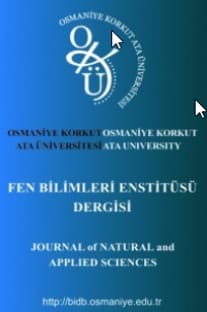A Study on Determination of The Fatty Acid Composition of Cucurbita pepo L. Seeds
In this study seed variety of Ürgüp Sivrisi pumpkin seeds collected from Çorum was used as material for determination fatty acid composition. It is known that; The seed of the pumpkin has active ingredients that protect and cure diseases. From past the present, it has been traditionally used for some diseases such as prostate and parasites. The pumpkin seeds contain average of 42-54% fat, and fatty acid composition depends on factors such as location, climate and maturity. According to the results of this study stearic, pamitic acid and linoleic acid respectively were found 0,46%, 0,52%, 0,05% degrees. In addition caprylic acid and palmitic acid were determinated at 0,37% and 0,52%. Butyric acid is important for inhibition of intestinal diseases. Reason of the many intestinal diseases are low butyric acid concentrations, in the colon. It shows the importance of using the pumpkin seeds in daily food habit.
Cucurbita pepo L. Tohumlarının Yağ Asidi Kompozisyonunun Belirlenmesi Üzerine Bir Çalışma
Bu çalışmada yağ asidi kompozisyonunun belirlenmesinde materyal olarak Çorum'da yetiştirilen Ürgüp Sivrisi ticari çeşidi kabak çekirdeği kullanılmıştır. Bilindiği gibi; Kabak çekirdeği bazı hastalıklara karşı koruyucu ve tedavi edici aktif bileşenlere sahiptir. Geçmişten günümüze geleneksel olarak prostat ve parazitler gibi bazı hastalıklar için kullanılmıştır. Kabak çekirdeği ortalama %42- 54 yağ içerir ve yağ asidi bileşimi yer, iklim ve olgunluk gibi faktörlere bağlı olarak değiştiği bilinmektedir. Bu çalışmanın sonuçlarına göre stearik, palmitik asit ve linoleik asit sırasıyla %0,46,%0,52, %0,05 oranlarında bulunmuştur. Ayrıca kaprilik asit ve palmitik asit %0,37 ve %0,52 olarak belirlenmiştir. Bütirik asidin, bağırsak hastalıklarının inhibisyonu için önemli olduğu bilinmektedir. Birçok bağırsak hastalığının nedeni, kolondaki düşük bütirik asit konsantrasyonları olabileceği düşünülmektedir. Bütün bu özellikleri değerlendirildiğinde Kabak çekirdeğinin günlük besin alışkanlığında kullanılmasının önemli olduğu fikri ortaya çıkmıştır.
___
[1.] Krzebietke SJ, Sienkiewicz S, 2010. Effect of foliar application of anthracene and pyrene (PAH) on yields and chemical composition of butterhead lettuce (Lactuca sativa L.) grown under varied abundance of substrate in nutrients. J. Elem., 15(3):531-538.[2.] Paris HS, 2001. History of the cultivar-groups of Cucurbita pepo (Janick J. Eds.). Horticultural Reviews. 25: 71–170.
[3.] Tüik 2015. Turkish statistical institute. (https://biruni.tuik.gov.tr/bitkiselapp/bitkisel.zul). Accessed 15 November 2016. [4.] Düzeltir, B, 2004. Description of pumpkin lines for seed (Cucurbita pepo L.) by morphological characteristics and selection studies. M.Sc. thesis (unpublished). Dept. of Horticulture, Ankara University, Ankara, Turkey.
[5.] Keskin L, 2007. Çekirdek Kabak Yetiştirciliği, Sorunları ve Çözüm Önerileri. M.Sc Seminary, Dept. of Horticulture, Selcuk University, Konya, Turkey (in Turkish).
[6.] Yavuz D, Yavuz N, Seymen M, Türkmen Ö, 2015. Evapotranspiration, crop coefficient and seed yield of drip irrigated pumpkin under semi-arid conditions. Scientia Horticulturae, 197: 33–40.
[7.] Murkoviç M, Hillebrand A, Winkler J, Pfannhauser W, 1996. Variabilitiy of vitamin e content in pumpkin seeds (Cucurbita pepo L.). Z Lebensm Unters Forsch., 202: 275-278.
[8.] Murkoviç M, Hillebrand A, Draxl S, Winkler J, Pfannhauser W, 1999. Distribution of fatty acids and vitamin e content in pumpkin seeds (Cucurbita pepo L.) in breeding lines. Acta Hortic, 492: 47– 55.
[9.] Türkmen Ö, Uslu N, Paksoy M, Seymen M, Fidan S, Özcan MM, 2015. Evaluation of fatty acid composition, oil yield and total phenol content of various pumpkin seed genotypes. La Rivista Italiana Delle Sostanze Grasse., 92: 93-97.
[10.] Seymen M, Uslu N, Türkmen Ö, Juahaimi FA, Özcan MM, 2016. Chemical compositions and mineral contents of some hull-less pumpkin seed and oils. J. Am. Oil Chem. Soc., 93: 1095-1099.
[11.] Kayahan, M., 2003. Yağ Kimyası. ODTÜYayıncılık Ankara, 220 s.
[12.] Bayraktar, B. 2017. Bayburt’ta Organik Tarım ve Hayvancılığın Mevcut Durumu. Türk Tarım – Gıda Bilim ve Teknoloji Dergisi, 5(13): 1762-1768.
[13.] IUPAC Standard method 2.301. Standards methods for the analysis of oils, fats and derivatives (7th ed.)International Union of Pure and Applied Chemistry, Blackwell, Oxford, England (1992) (1st supplement. to the 7th ed.)
[14.] REGULATION, H. 1991. Commission Regulation (EEC) No. 2568/91 of 11 July 1991 on the characteristics of olive oil and olive-residue oil and on the relevant methods of analysis Official Journal L 248, 5 September 1991. Official Journal L, 248, 1-83.
[15.] Kumar CM, Rachappaji KS, Nandini CD, Sambaiah K, Salimath PV. Modulatory effect of butyric acid—a product of dietary fiber fermentation in experimentally induced diabetic rats. The Journal of nutritional biochemistry. 2002;13(9):522-527.
[16.] Spina L, Cavallaro F, Fardowza NI, Lagoussis P, Bona D, Ciscato C, Rigante A, Vecchi M. Butyric acid: pharmacological aspects and routes of administration. Digestive and Liver Disease Supplements. 2007;1(1): 7-11.
[17.] Çağlar, A., Tomar O., Ekiz T.,2017. Bütirik Asit: Yapısı, Özellikleri ve Sağlık Üzerine Etkileri. Kocatepe Vet J. 10(3): 213-225.
[18.] Zeybek U (2006). www.bukas.com.tr /product.asp (izlenme tarihi 18.07.2011)
[19.] Younis Y.M.H, Ghirmay S., Al-Shihryc S.S. (2000). African Cucurbita pepo L.: properties of seed and variability in fatty acid composition of seed oil. Phytochemistry 54: 71-75.
[20.] Hernández-Santos B., Rodríguez-Miranda J., Herman-Lara E., Torruco-Uco J.G., Carmona-García R., Juárez-Barrientos J. M., Chávez-Zamudio R., Martínez-Sánchez C. E., (2016). Effect of oil extraction assisted by ultrasound on the physicochemical properties and fatty acid profile of pumpkin seed oil (Cucurbita pepo). Ultrasonics Sonochemistry 31: 429–436.
[21]. Doğan B, Çelik M, Ünal M, Sefalı A, Martin E, Kaya A. (2016). Study of phylogenetic relationship of Turkish species of Matthiola (Brassicaceae) based on ISSR amplification. Turk J Bot. 40: 130-136.
- ISSN: 2687-3729
- Yayın Aralığı: Yılda 3 Sayı
- Başlangıç: 2017
- Yayıncı: Osmaniye Korkut Ata Üniversitesi
Sayıdaki Diğer Makaleler
Biyodizel Yan Ürünlerinin Hayvan Beslemede Kullanımı
Yeni Doğan Buzağıların Beslenmesinde Ağız Sütünün Önemi
Gültekin ÖZDEMİR, B. Devrim ÖZCAN
Berkay KARACOR, MUSTAFA ATAKAN AKAR, Mustafa ÖZCANLI, Hasan SERİN, Oğuz BAŞ
Cucurbita pepo L. Tohumlarının Yağ Asidi Kompozisyonunun Belirlenmesi Üzerine Bir Çalışma
Muhammad FARHAB, Madeeha AKRAM, Ijaz SALEEM, Zubair LUQMAN
Interaction Shallow Tunnels and Structures
